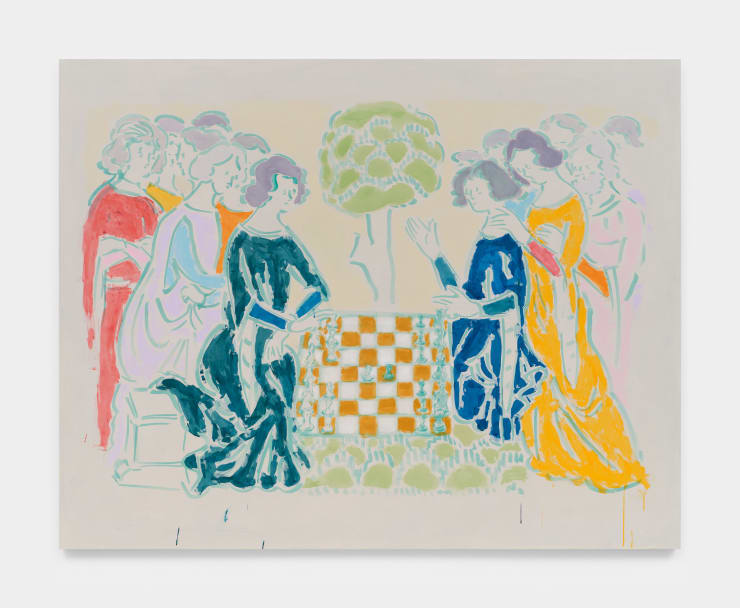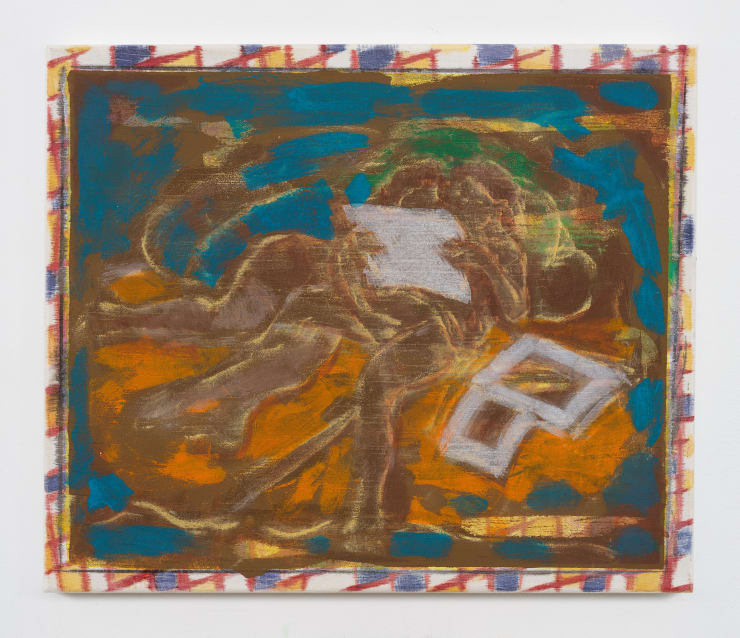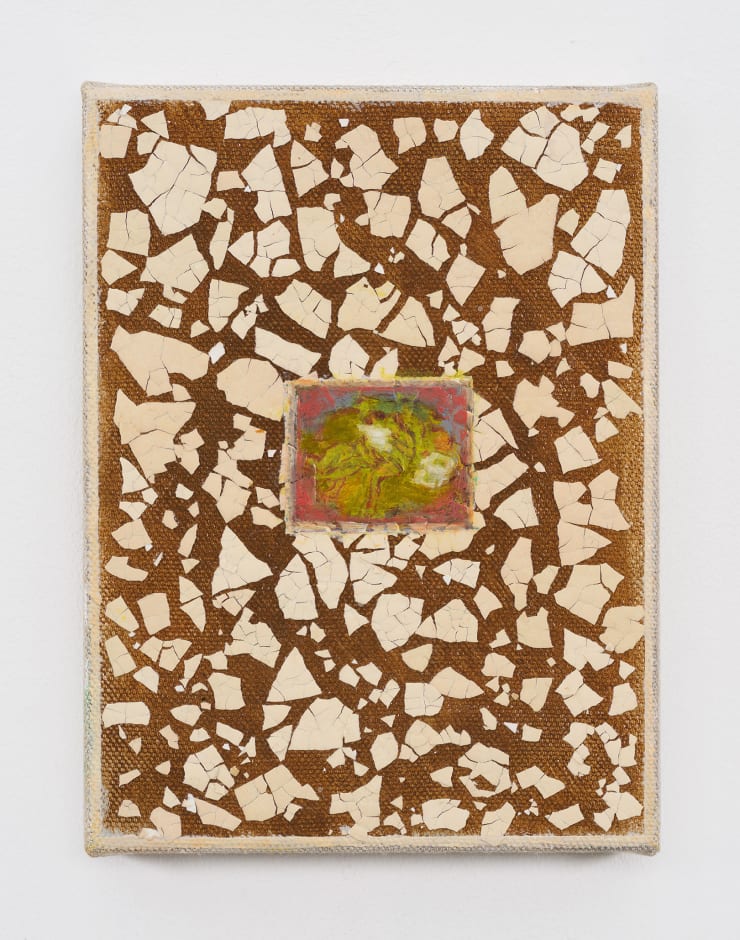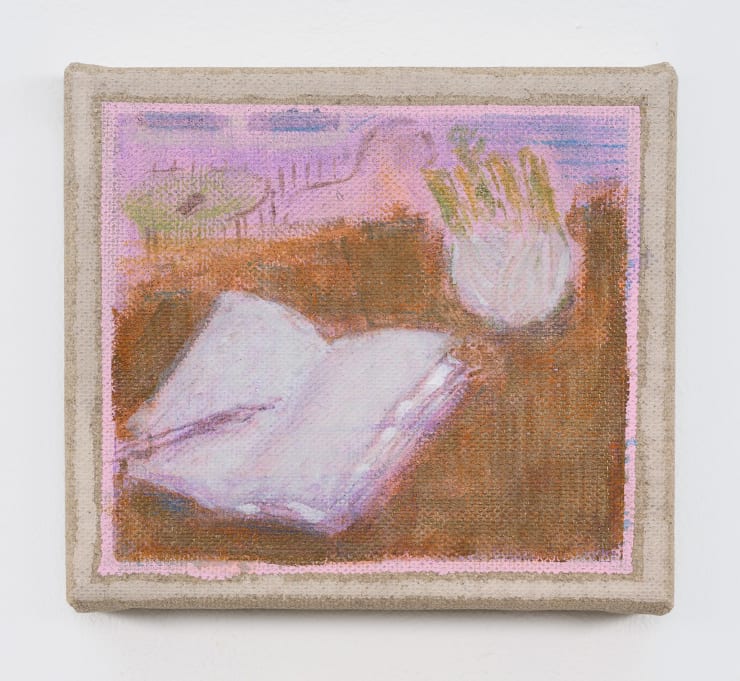‘Like the other, the game is infinite’
- Jorge Luis Borges
No Blunder at Sebastian Gladstone is Cosima zu Knyphausen’s first solo show in the United States, presenting a body of work by the artist consisting of 20 recent paintings.
Over the years, zu Knyphausen has explored art historical motifs through quoting, paraphrasing, and appropriation to envision an alternative canon shaped by lesbian desire. In No Blunder, this common thread in her practice metaphorically questions ideas about the relationship to the ‘other’ from the standpoint of the game of chess. Influenced by a close relative who is obsessed with the game, zu Knyphausen started to weave a sense of paradox between forethought and the premeditative characteristic of chess, and the fortuitous and erratic condition of the unpredictable forces in human encounters.
In her biggest work in the exhibition, La Partida (the chess game) (2024), two groups of women in the style of a renaissance painting appear to face each other in the inaugural move of a chess game. Upon closer look at the chessboard, something seems odd: the row where the king would stand is absent. This detail, which may seem only like a blunder, suggests the possibility of re-imagining fundamental principles around human desire, gender and society.
A recurring motif in the exhibition is the image of two lascivious figures lying down and looking at an image together. Inspired by an illustration by artist Gerda Wegener, the variations on this complicit scene reflect on Anne Carson’s notion that desire and love come from “an edge between two images that cannot merge in a single focus. (…) To know both, keeping the difference visible, is the subterfuge called Eros”. Similarly, chess is a game in which two colors on the board never merge. Insurmountable moves weave the relationship between two players, a libidinal assertion of exchange between strategic (or impulsive) locomotion and sacrifices.
Cosima zu Knyphausen uses a variety of materials and painting techniques – from eggshell mosaics, patchwork from scraps of other canvases to the use of medieval checkered backdrops– to express the desires inspired by motifs from often hidden queer stories of the past. The work Muster: win-win (2023-24), for example, takes the well-known thematic of Caspar David Friedrich where two men admire a dramatic landscape in a complicit way. In zu Knyphausen’s version, they are followed by two women enchanted not only by the view, but by their tender intimacy far from the gaze of the men. This image appears on top of a tic-tac-toe grid in which both O and X are winners, suggesting a scenario where all characters are allowed their stories.
A shaking rose (2024) provides a more contemporary facsimile, where actress Lily Rose Depp embraces her girlfriend rapper 070 Shake in a vivid array of pastel coloring.
Two paintings, however, seem to diverge from the theme of shared complicity or opposition: one features Narcissus, fixating on himself, (Muster (Narciso) (2022)) and the other, a bar stool-seated character rejoicing in the constant refill of a glass of wine (abcdefgh (2024)). Both add to the overarching theme of chess in that they lack an opponent, partaking in a repetitive spiral with themselves. Contrary to this, Lontananza (2023) and Monte Aconcagua (2024) emphasize how distance, forethought and perspective only exist in the gap between landscape and observer.
Other references in the show include the painter Monica Briones, Chile’s first known victim of a hate crime against lesbians, the view from the Santiago valley by Alejandro Cicarelli, a checkmate by greatest female chess champion Judith Poglar, and others. There even is one blunder: a chessboard meant to have 7 rows on one side but, instead, it has 9. This was noticed later by the artist, facing the irony of her own blunder staring at her in silence.
Blunder is a word used in chess to refer to a mistake that could be detrimental to the player’s chances against another, even if several moves ahead. Far from apologizing for conjuring past references, Cosima zu Knyphausen captures us with her eloquence, visionary imagination and artistic skill, installing an (eggshell) chessboard between spectator and motif, leaving the edges between them as a space for interpretation.
-Philippa zu Knyphausen
-
 Cosima zu Knyphausen, La Partida, 2024
Cosima zu Knyphausen, La Partida, 2024 -
 Cosima zu Knyphausen, abcdefgh, 2022-24
Cosima zu Knyphausen, abcdefgh, 2022-24 -
 Cosima zu Knyphausen, Muster (Narciso), 2022
Cosima zu Knyphausen, Muster (Narciso), 2022 -
 Cosima zu Knyphausen, No Blunder, 2024
Cosima zu Knyphausen, No Blunder, 2024 -
 Cosima zu Knyphausen, Muster (win-win), 2024
Cosima zu Knyphausen, Muster (win-win), 2024 -
 Cosima zu Knyphausen, egg mosaic V (Hay un masoquismo ahí por el que sentís que tení que pasar para llegar a la experiencia), 2024
Cosima zu Knyphausen, egg mosaic V (Hay un masoquismo ahí por el que sentís que tení que pasar para llegar a la experiencia), 2024 -
 Cosima zu Knyphausen, Lontananza, 2023
Cosima zu Knyphausen, Lontananza, 2023 -
 Cosima zu Knyphausen, Re: an edge between two images (5), 2024
Cosima zu Knyphausen, Re: an edge between two images (5), 2024 -
 Cosima zu Knyphausen, Monte Aconcagua, 2023
Cosima zu Knyphausen, Monte Aconcagua, 2023 -
 Cosima zu Knyphausen, atávico margen, 2024
Cosima zu Knyphausen, atávico margen, 2024 -
 Cosima zu Knyphausen, Re: an edge between two images (3), 2023
Cosima zu Knyphausen, Re: an edge between two images (3), 2023 -
 Cosima zu Knyphausen, Cloudy conditions will continue all day, 2023
Cosima zu Knyphausen, Cloudy conditions will continue all day, 2023 -
 Cosima zu Knyphausen, Seam Allowance, 2023
Cosima zu Knyphausen, Seam Allowance, 2023 -
 Cosima zu Knyphausen, Re: an edge between two images (4), 2024
Cosima zu Knyphausen, Re: an edge between two images (4), 2024 -
 Cosima zu Knyphausen, Dos Hermanas, 2024
Cosima zu Knyphausen, Dos Hermanas, 2024 -
 Cosima zu Knyphausen, A shaking rose, 2023
Cosima zu Knyphausen, A shaking rose, 2023 -
 Cosima zu Knyphausen, Así eran las griegas, 2023
Cosima zu Knyphausen, Así eran las griegas, 2023 -
 Cosima zu Knyphausen, Re: an edge between two images (2), 2020-2023
Cosima zu Knyphausen, Re: an edge between two images (2), 2020-2023 -
 Cosima zu Knyphausen, Mónica Briones aprovecha de terminar su cuadro, 2023
Cosima zu Knyphausen, Mónica Briones aprovecha de terminar su cuadro, 2023 -
 Cosima zu Knyphausen, Something I wrote, 2023
Cosima zu Knyphausen, Something I wrote, 2023































